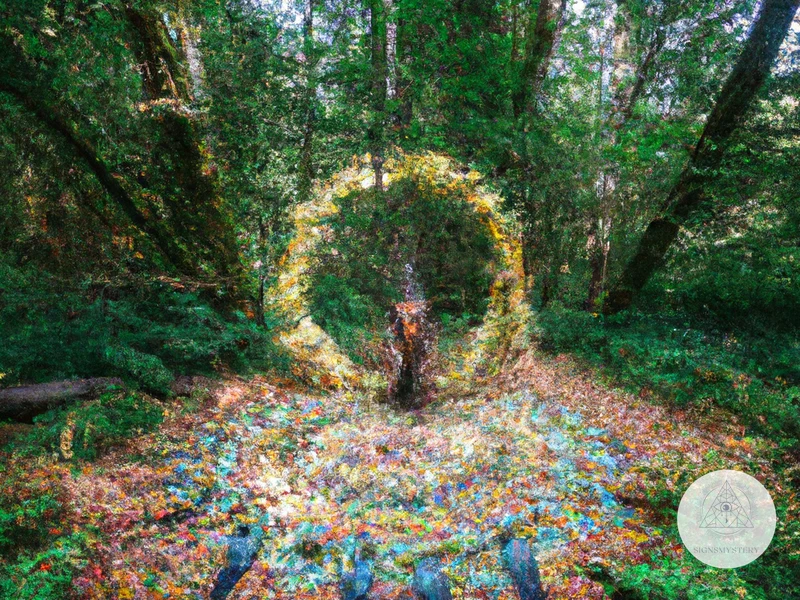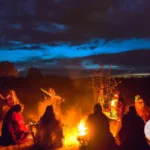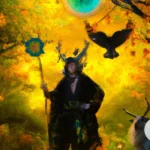Shamanism has been an integral part of human culture for thousands of years, existing in various forms throughout the world. Although it is often associated with indigenous tribes and cultures in places such as Siberia and South America, shamanism also has a rich history in Japan. Despite the country’s modernization and shift away from traditional beliefs, shamanistic elements can still be seen today in Japanese folklore, mythology, and even contemporary culture. In this article, we will explore the basics of shamanism, its variations in different cultures, and delve into the influence of shamanism in Japanese folklore and mythology.
What Is Shamanism?

Shamanism is a spiritual practice that has been followed by various cultures and societies for thousands of years. It involves a shaman, who is a person that acts as a mediator between the spirit world and the physical world. The shaman performs rituals, communicates with spirits, and uses natural remedies to heal illnesses or to bring balance and harmony to individuals and communities. Shamanism has many variations across different cultures and regions, each with their own unique beliefs and practices. Some examples of shamanism include Native American shamanism, African shamanism, Siberian shamanism, and Australian Aboriginal Dreamtime shamanism. However, despite the differences, there are some common elements that define shamanism as a whole, such as the belief in the spirit world and the use of altered states of consciousness.
The Basics of Shamanism
Shamanism is a spiritual practice that involves a practitioner, called a shaman, who seeks to communicate with the spirit world. Shamans have existed across various cultures worldwide for thousands of years. They differ from one culture to another, but there are certain basic principles that are common across all shamanistic traditions.
Here are some of the basics of shamanism:
| Basic Principle | Explanation |
|---|---|
| Communication with Spirits | Shamans seek to communicate with spirits to learn from them, seek guidance, and heal people who are sick or injured. |
| Connection with Nature | Shamans believe that everything in nature is alive and has a spirit. They establish a connection with nature through rituals and use it for healing and guidance. |
| Trance States | Shamans enter altered states of consciousness, also known as shamanic trance states, to communicate with spirits and gain access to non-ordinary reality. |
| Healing Practices | Shamans use various techniques to heal people who are ill. These techniques include spiritual healing, energy work, and the use of medicinal plants. |
Shamanic traditions have been a part of various cultures throughout human history. For instance, shamanism in ancient civilizations like Egypt, Greece, and Rome was linked to religious practices and medical treatments. Central Asian shamanism also has a deep connection with nature and focuses on healing as well as spirituality. Even in modern Western culture, many shamanic practices are still used today, such as meditation, energy work, and other forms of healing.
Shamanism is a spiritual practice that has survived through different cultures and traditions. The basic principles of shamanism involve communication with spirits, connection with nature, altered states of consciousness, and healing practices.
Variations of Shamanism in Different Cultures
Shamanism is a prominent spiritual practice in many cultures around the world, and it takes on unique forms in each of these cultures. Here are a few examples of shamanic variations across different cultures:
Mongolian Shamanism: Known as Tengerism, Mongolian shamanism involves the belief in a multitude of gods, spirits, ancestors, and natural elements. The shaman serves as a mediator between the physical and spiritual worlds and performs rituals for healing, divination, and protection.
Native American Shamanism: Native American tribes have their own distinct shamanic traditions, such as the Lakota Sioux’s Heyoka tradition and the Hopi’s Kachina ceremony. These traditions involve the use of dance, song, and storytelling to communicate with the spirits and gain insights about the physical and spiritual worlds.
African Shamanism: African cultures have a rich diversity of shamanic practices, such as the Bantu medicine man and the Zulu sangoma. These practices often involve the use of herbs, crystals, and divination tools to heal and communicate with the spirits.
Shamanism in Western Culture: While shamanism is typically associated with indigenous cultures, it has also gained popularity in Western cultures as a form of alternative spirituality. Modern Western shamanism involves a blend of traditional shamanic practices with New Age beliefs and often incorporates the use of psychedelics, sound healing, and energy work.
Comparing shamanic traditions across different cultures highlights the ways in which spiritual practices are shaped by cultural context and geography. These variations in shamanic practices can be further explored in a comparative study of shamanic traditions.
Shamanistic Elements in Japanese Folklore and Mythology
Shamanism has long been an integral part of Japanese culture and mythology, and many of its elements are still evident today. Animism , the belief that all things, including inanimate objects, possess a spirit or soul, is a prominent concept in Japanese folklore. Kami, the spirits or deities of nature, are also commonly depicted in Japanese mythology, along with Yokai, supernatural creatures believed to inhabit the natural world. The practice of Shugendo by the mountain ascetics, which involves rituals and ascetic practices to gain spiritual power and enlightenment, is another example of shamanistic elements in Japanese culture. These beliefs and practices continue to influence Japanese society and are still celebrated in various folk festivals and rituals. While Western culture has its own version of shamanism, the shamanistic elements in Japanese folklore and mythology possess a unique and fascinating complexity.
Animism in Japanese Culture
Animism is the belief that objects, places, and creatures have a spiritual essence. It is one of the oldest belief systems in the world and still has a strong presence in the Japanese culture. The Japanese people have a deep respect for nature, and they believe that inanimate objects have a soul. This belief has led to the practice of kami worship, where people pay respect to different gods and goddesses that they believe inhabit various natural elements like plants, rocks, and water bodies.
The Japanese concept of animism is closely linked to their idea of shintai. In the shinto tradition, shintai refers to an object or item that symbolizes the presence of a kami or spirit. These objects can range from a simple stone or wooden pillar to an elaborate shrine with intricate carvings.
One well-known example of animism in Japanese culture is the tsukumogami. Tsukumogami are objects that have been around for a long time and acquire a spirit over time. These spirits are said to be mischievous and can cause chaos if they are not respected or treated with care.
Animism in Japan is not restricted to the natural world but also extends to the realm of yokai or supernatural beings. Yokai can take many forms, from mischievous to malevolent, and are believed to inhabit various parts of the physical world. These creatures are often depicted in Japanese folklore and art and are considered to be powerful beings that can influence human affairs.
Animism plays a significant role in Japanese culture and has had a lasting impact on the country’s folklore and mythology. The belief in spirits and the presence of kami has been reflected in the practice of shintoism and the reverence for nature. The concept of animism is not unique to Japan but can be found in various cultures worldwide, including some aspects of shamanism in Western culture.
Depiction of Yokai and Kami
In Japanese folklore, yokai and kami are supernatural beings that are often depicted in shamanistic practices. Yokai are creatures that embody the mysterious and eerie aspects of the natural world. They can take on many forms such as ghosts, demons, or even animals with supernatural abilities. Kami, on the other hand, are considered to be divine entities and are often associated with natural phenomena such as mountains, rivers, and trees.
In shamanistic practices, yokai and kami are often called upon to aid the shaman in their spiritual journey. For example, the shaman may communicate with kami in order to gain insight or guidance on their path. Yokai, on the other hand, may be summoned to assist the shaman in overcoming obstacles or to protect them from harm.
One of the most famous depictions of yokai in Japanese folklore is the story of Kappa, a mischievous water spirit that is said to live in rivers and lakes. Kappa are often portrayed in art as having a turtle-like shell and a beak-like mouth. They are known for their love of cucumbers and their habit of grabbing unsuspecting victims and pulling them into the water.
Another popular yokai is the Oni, a demon-like creature that is often depicted with a fierce expression and bulging eyes. Oni are known for their strength and are often seen as a symbol of protection against evil spirits.
Kami, on the other hand, are often depicted as benevolent beings that protect and guide humans. One such kami is Amaterasu, the goddess of the sun and the central figure in the Shinto religion. Amaterasu is said to provide light and warmth to all living things and is revered as a symbol of life and creation.
The depictions of yokai and kami in Japanese folklore and mythology provide a rich source of inspiration for shamanistic practices. These supernatural beings are often seen as intermediaries between humans and the divine, and can offer guidance and protection to those who seek it.
Shugendo and the Mountain Ascetics
Shugendo is a religion in Japan that combines Buddhism, Taoism, and Shintoism, and it has a close connection with mountain ascetics. The practice of Shugendo involves rigorous ascetic and mystical rituals in mountainous areas. Mountain ascetics are known as yamabushi, which translates to “Those who lie down in the mountains”. They are often depicted as spiritual hermits who possess mysterious powers and are deeply connected to nature.
The practices of Shugendo revolve around purification, training, and enlightenment. Purification rituals involve fasting, meditation, and ablution in waterfalls and other natural spots. Training rituals are necessary to develop mental and physical strength to endure the intense disciplines of the religion. Enlightenment rituals help the practitioners to attain greater spiritual awareness and commune with the divine forces of nature.
The mountain ascetics of Shugendo often wear distinctive clothing and accessories, including a white robe with a black hat, a stick called a shakujo used to ward off snakes or evil spirits, and a suzu, a small brass bell used for purification. They are also known for their distinctive shamanistic chants, dances, and music that are believed to evoke supernatural powers during rituals.
In Japanese folklore and mythology, mountain ascetics are often depicted as bridge-builders between the human and spiritual realms. They are believed to have the power to ward off evil spirits, cure illnesses, and ensure good harvests. The mountain ascetics of Shugendo have played an important role in preserving Japan’s indigenous culture and folk beliefs.
Even today, Shugendo and mountain ascetics continue to have a significant influence on Japanese culture. Many people still undertake pilgrimages to sacred mountains in Japan, seeking spiritual purification and enlightenment. The practices of Shugendo, including its purificatory rituals and shamanistic chants, have been handed down from generation to generation through various folk festivals and cultural events.
Shugendo and mountain ascetics are an essential part of Japan’s religious
Subscribe to Our Newsletter
Sign up to receive the latest news and updates.
Shamanism in Modern Japan
Shamanism in modern Japan has undergone significant changes, yet it still lingers in the form of folk festivals, rituals, and adapted beliefs. These practices are linked to Japanese spiritualism and animism, which emphasize reverence for natural forces and living things. One example of such practices is the famous Aomori Nebuta Festival, where giant, illuminated lanterns depicting mythical creatures are paraded around the city. Another example is the practice of Oharai, which is aimed at purifying the mind and body by driving away negative energies. Today, shamanistic beliefs have been adapted to fit into contemporary Japanese culture, with individuals seeking guidance and healing from modern-day shamans known as “jyorei masters”. Despite changes, shamanism remains embedded in Japanese culture, surviving through modern rituals and beliefs.
Survival of Shamanism through Folk Festivals and Rituals
The survival of shamanism through folk festivals and rituals in Japan is a testament to the deep-rooted beliefs of the Japanese people. These festivals and rituals have evolved over the years, adapting to changing social and cultural landscapes, while still preserving shamanistic elements. Let’s take a closer look at some of these festivals and rituals.
Bon Festival: The Bon festival, also known as the Festival of the Dead, is celebrated in mid-August and is one of the most popular festivals in Japan. During this festival, people visit their ancestor’s graves to offer food and incense, and it is believed that the spirits of the dead return to the world of the living for a brief time. This festival has shamanistic roots, as it is believed that the priests can communicate with the spirits of the dead and guide them to the world of the living.
Harvest Festival: The Harvest Festival, known as Niiname-sai, is a Shinto festival that takes place in November. During this festival, the first crops of the year are offered to the gods, and prayers are offered for a bountiful harvest in the coming year. Shintoism is closely linked to nature, and this festival is a celebration of the bounty of nature, which is revered as a living entity imbued with spiritual power.
Fire Festivals: Fire festivals, also known as torch festivals, are held throughout Japan and are believed to have shamanistic roots. These festivals involve lighting large torches and carrying them through the streets to ward off evil spirits and bring good luck. One of the most famous fire festivals is the Nozawa Onsen Dosojin Matsuri, which takes place in January and is believed to bring good luck and fertility.
Kamakura Festival: The Kamakura Festival takes place in February and is held in honor of the water deities. During this festival, miniature snow huts are built and decorated with various offerings to the gods. The huts represent the ancient practice of building snow huts to pray for a bountiful harvest and to ask for protection from evil spirits.
These examples show how shamanistic beliefs have survived in Japan through folk festivals and rituals. While some of these festivals have lost their explicit shamanistic connections over time, the roots of shamanism can still be seen in the rituals and practices of Japanese culture.
Adaptation of Shamanistic Beliefs in Contemporary Japanese Culture
The adaptation of shamanistic beliefs in contemporary Japanese culture is a fascinating topic that showcases the lasting impact of ancient practices on modern society. Today, shamanism in Japan has transformed and taken on new forms, blending with other religious and spiritual beliefs to create unique expressions of spirituality.
One notable example of shamanism’s adaptation in modern Japan is the emergence of urban shamans or “life counselors”. These individuals draw on shamanic practices to provide guidance and healing to individuals seeking spiritual connection in a fast-paced city life. These modern shamans often use a combination of shamanic tools such as drums, rattles, and meditative states to facilitate deep healing and introspection.
Another way in which shamanism has adapted in modern Japan is through the integration of shamanic elements in popular culture. Anime and manga, two prominent forms of Japanese popular culture, often incorporate shamanistic themes and symbolism. For example, the series Shaman King features characters who can communicate with spirits and work with them to perform extraordinary feats.
Yet another example of the adaptation of shamanistic beliefs in contemporary Japan can be seen in the fusion of Shinto and shamanism. Shinto, a traditional Japanese religion, emphasizes the worship of kami or spirits, while shamanism centers around the belief in the power of the natural world and spiritual entities. Some individuals have merged these two practices to create a unique spiritual practice that draws on both traditions.
The adaptation of shamanistic beliefs in contemporary Japanese culture has allowed these ancient practices to continue to thrive and evolve in modern times. From urban shamans to popular culture, the integration of shamanism into contemporary Japanese society showcases the enduring influence of these ancient practices on the culture and spirituality of Japan.
Conclusion
In conclusion, the study of shamanism in Japanese folklore and mythology reveals the deep influence of spiritual practices in this ancient culture. From animism to the depiction of yokai and kami, shamanistic elements persist in the mythological stories that have been passed down through generations. Shugendo and the practices of the mountain ascetics demonstrate the continued relevance of shamanism in contemporary Japanese culture. Additionally, shamanistic beliefs have adapted and evolved in modern Japan, manifesting in various folk festivals and ritual practices.
It is remarkable how the customs and beliefs of shamans have persisted in Japan despite external pressures and historical changes. The tenacity of shamanistic practices in this culture paints a picture of a society that deeply values spirituality and the connection to the natural world. As we continue to explore the intricacies of shamanism in Japan and other cultures, we gain valuable insights into the human psyche and the diverse ways in which we seek to understand the world around us.
Overall, the study of shamanism in Japanese folklore and mythology is a testament to the enduring power of spiritual practices. It reminds us that despite the many changes and challenges we face, our spiritual pursuits have the potential to provide us with a sense of meaning and purpose in our lives. As we navigate the complexities of the modern world, we can draw inspiration from the rich history of shamanism in Japan and other cultures as we seek to create a brighter future for ourselves and for generations to come.
Frequently Asked Questions
What is the history of shamanism in Japan?
Shamanism has been a part of Japanese culture for centuries, with roots in ancient animistic beliefs and practices.
What are the basic principles of shamanism?
The basic principles of shamanism include connecting with the spiritual world, journeying to other realms, and channeling spiritual energy to heal and bring balance.
How has shamanism evolved in Japan?
Shamanism in Japan has evolved through various cultural influences, including Buddhism and Shintoism, resulting in unique practices and beliefs.
What is animism in Japanese culture?
Animism is the belief that all things, including objects and natural phenomena, possess a soul or spirit. This belief is an integral part of Japanese folk culture and mythology.
What are yokai and kami in Japanese folklore?
Yokai are supernatural creatures or monsters in Japanese folklore, while kami are divine beings or spirits that are revered and worshiped in Shinto religion.
What is shugendo and how does it relate to shamanism?
Shugendo is a Japanese religion that combines elements of Buddhism, Shintoism, and other indigenous beliefs. It is characterized by ascetic practices, mountain worship, and shamanistic rituals.
How has shamanism survived in modern Japan?
Shamanism persists in modern Japan through the continuation of folk festivals and rituals, as well as the adaptation of shamanistic beliefs in contemporary culture.
What are some examples of shamanistic practices in modern Japan?
Examples of shamanistic practices in modern Japan include omikuji (fortune-telling divination), yin-yang divination, and the use of charms and talismans for protection and good luck.
How has shamanism influenced popular culture in Japan?
Shamanistic imagery and symbolism have been incorporated into various forms of popular culture in Japan, including anime, manga, and video games.
What is the significance of shamanism in contemporary Japan?
Shamanism in contemporary Japan serves as a way for individuals to connect with spiritual traditions and seek balance and healing in their lives.










